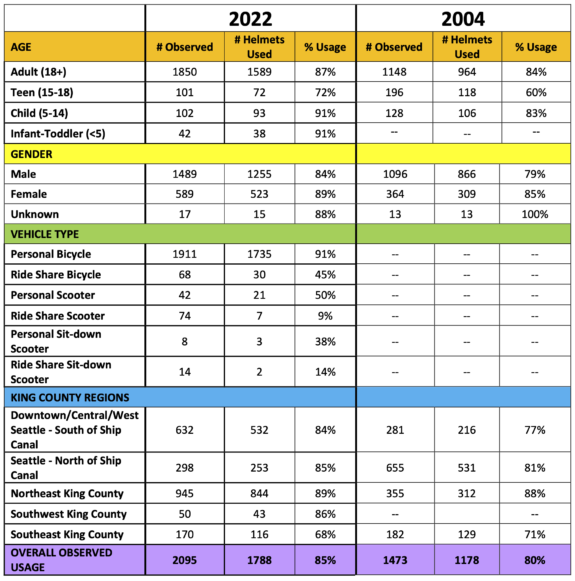One year ago, the King County Board of Health
voted 11–2 to repeal the county’s rare all-ages bicycle helmet law. One of the arguments in favor of repeal was that the law was not a top reason that most people choose to wear a helmet. To test this assertion, Public Health – Seattle & King County conducted
an observational study (PDF) to assess helmet use after the repeal went into effect. And sure enough, helmet use remains high across King County, especially for people riding their own bicycles.
Researchers counted about 2,000 people at more than 50 different locations around the county. 91% of riders on personal bicycles wore a helmet while 45% of bike share users wore one. Only 9% of scooter share riders wore a helmet. Together, bike and scooter helmet use sat at 85%, with is higher than the 80% a similar study found in 2004. As David Kroman
noted in the Seattle Times, the results are also nearly identical to
a 2018 study led by a group of Harborview and UW researchers. This suggests that people are choosing to wear a helmet for reasons separate from the threat of police action, such as feeling safer with head protection.
It is probably worth revisiting this study in a few years to see if things change with time, but this initial result is a good sign that the Board’s reasoning was indeed sound. It should also be instructive for other places considering a helmet law repeal. The King County Board of Health was clear during deliberations that they supported the use of helmets, but they had concerns about inequitable enforcement. Black people in Seattle were 3.8 times more likely to get a helmet citation than a white person, an analysis by the volunteer-led Helmet Law Working Group found. “Differences in helmet use between populations cannot explain these disparities,” the group noted in their report. These figures do not account for stops that did not result in a citation.
On somewhat of a side note, the bike share figure is surprisingly high considering riders would have needed to plan ahead and bring a helmet with them. The sample size was 68, which seems significant enough to take seriously. As someone who owns a bike, my bike share use is mostly limited to spontaneous trips when I’m already out and about and unlikely to have a helmet with me. But I guess there are a lot of users who leave home knowing they are going to be using bike share to get around. It also suggests diverging use cases for shared bikes compared to shared scooters. Are scooters more likely to be used spontaneously while the bikes are more likely to be part of a user’s plan? We already know that bike share trips tend to be longer in distance than scooter trips, so perhaps this is another clue. It also suggests that there is value in bike share separate from scooter share, and that the two device types should not be considered interchangeable by government policy writers or by the companies offering them.







